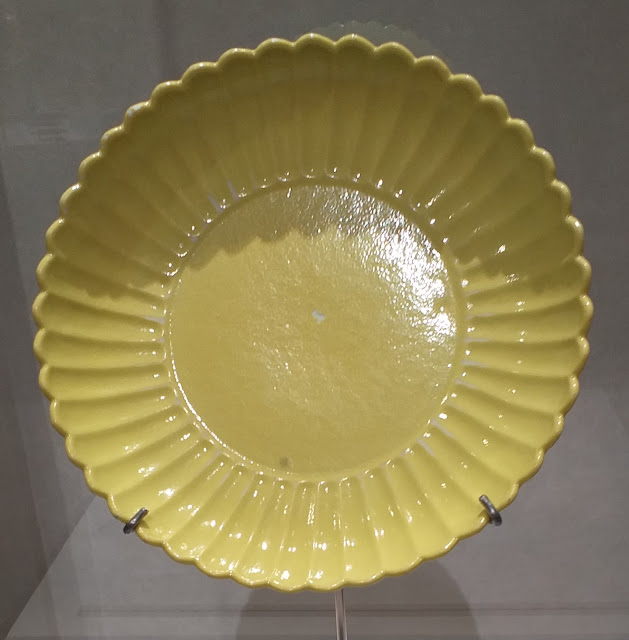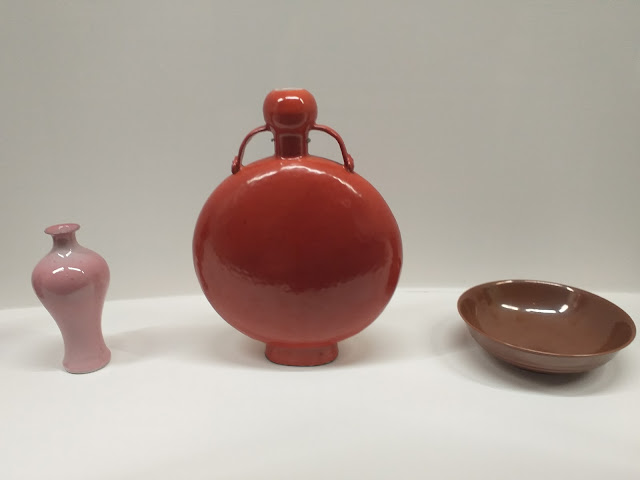 |
| Phoenix-head ewer green-glazed earthenware 10th century |
The Exhibition at the Musée Guimet contains priceless porcelain bowls, dishes, vases and spittoons! It is laid out in colour sections. The 10th C. ewer above is one of the oldest objects on display, the age of the pots on show ranging from the 8th to the 19th centuries. The colour green couldn't be used on porcelain, because of the low firing temperature of copper oxide, so it was mainly used on earthenware as a glaze.
The first section of the exhibition concentrates on pure white porcelains which were so highly prized from the 8th and 9th centuries onwards. The most beautiful pieces were reserved for the Emperor or princely courts:
 |
| Ewer from the Ding Kilns white porcelain 10th-11th century (Song dynasty) |
Emperors had the wares imprinted with their own special mark:
 |
| Coral enamelled porcelain Qing dynasty (reign of Yongzheng 1723-1735) Zhuyuetang Collection |
Gradually other colours were introduced into pottery making, despite an initial reticence. Over a thousand year period, Chinese pottery masters succeeded in producing all colours, although some were more difficult than others. Colours have a symbolic value in China- for example red signifies happiness and festivity. It was produced using copper, which at a different temperature produces green- the colour of fertility and also purity. Blue represents the sky, while yellow signifies the earth and was the imperial colour.
 |
| Chrysanthemum shaped dish with lemon yellow enamel stamped in the reign of Qianlong (1736-1795) |
By the 18th century, the kilns of Jingdezhen, China's 'porcelain capital', had worked out how to perfect a turquoise enamel glaze on porcelain. The dish below, decorated round the edge with floral motifs, was meant for washing paintbrushes:
 |
| Brush washing dish porcelain with turquoise enamel Qing dynasty (1736-1795) |
This dish forms part of the Zhuyuetang Collection, several pieces of which have been lent by Hong Kong collector Richard W.C. Kan. Another beautiful piece lent by Mr Kan is a vase in the form of a double gourd representing the harmony of sky and earth. The colour is a pale celadon, a much-prized colour which may range from brown to bluish-grey to sea green:
 |
| Large double-gourd vase. Pale celadon covered porcelain from the kilns of Jindezhen Qing dynasty from the reign of Qianlong (1736-1795) |
The harmony of earth and heaven is similarly symbolised in the double vase below from the same provenance and period:
 |
| lavender blue double vase Qing dynasty (reign of Yongzheng 1723-1735) |
This double vase belongs to the Musée Guimet, which owns the largest collection of Chinese ceramics in France. It was founded by Emile Guimet in 1889. Many pieces, like the above blue double vase, came from explorer Ernest Grandidier, head curator of Chinese ceramics at the Louvre. At his death in 1912, his collection was given to the Louvre and later transferred to the Guimet in 1945. The red porcelain below also came from the Grandidier Collection:
 |
| 19thC baluster vase, 19thC red gourd-shaped bottle, 18thC iron brown dish |
 |
| 19th C Qing Dynasty dark purple porcelain vase, earthenware Yuhuchunping vase 13th C Yuan Dynasty, aubergine glazed porcelain bowl Qing dynasty, 19th C |
 |
'Changing colours' bottle vase Qing Dynasty (Reign of Yongzheng 1723-1735) |




Comments
Post a Comment